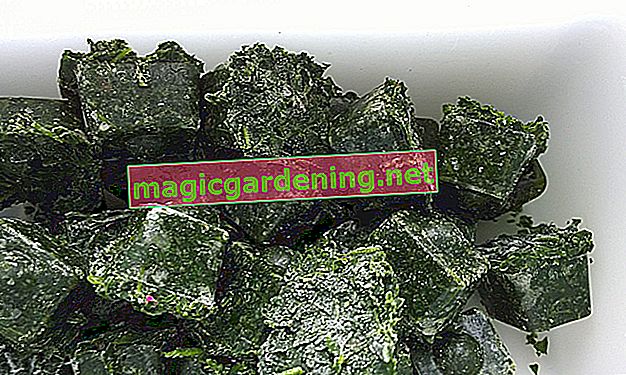
the essentials in brief
- Dried fruit moths can be fought with pheromone traps, chemical or home remedies or beneficial insects
- Hot air kills larvae and pupae
- Essential oils like lavender, clove or cedar confuse adult moths
- As a preventive measure, food should be tightly closed and newly purchased goods should be checked regularly
Fight dried fruit moths
Anyone who has ever discovered an infestation by the dried fruit moth needs patience. If you want to get rid of the pests, you shouldn't just take direct action to combat them. Prevention is just as important so that the drama doesn't repeat itself again.
also read
- Ground cover for the shade - attractive survivors
- Handle only with gloves: the box tree moth is poisonous
- Profile of the hover fly
Pheromone trap
Such a trap contains sexual attractants that the males are attracted to. They stick to the adhesive surface after landing. However, this measure is not suitable for combating, since neither females nor larvae are attracted to the fragrances. You can use pheromone traps to check whether there are any dried fruit moths in your household. The attractants are species-specific, so you need a product specifically for the dried fruit moth. The traps can be used for several weeks.

Chemicals
Various insecticides are available in stores that can be used to destroy the larvae. The products often contain the natural substance pyrethrum, which is obtained from different Tanacetum species. They are sprayed into the hiding places of the larvae, so that they perish within a short time.
There are special insect strips to combat dried fruit moths. They consist of a fleece that is protected by a grid. Over several months, the fleece exudes a chemical agent in the room air that is supposed to destroy the moths. However, such chemical agents are not safe for humans either.
Beneficial insects
The use of parasitic wasps (14.59 € at Amazon *) of the genus Trichogramma is effective and harmless to health. They live parasitically and lay their eggs in the eggs of the dried fruit moth with a long laying stinger. The wasp larvae eat the eggs from the inside. Adult parasitic wasps look for new clutches to lay their eggs. While the beneficial insects are doing their work, you should not reach for the vacuum cleaner.
Advantages:
- Beneficial organisms are hardly noticed
- no danger to humans
- Ichneumon wasps disappear as soon as they cannot find any moth eggs
Eliminate with home remedies
Dried fruit moths avoid certain foods such as fats and oils, sugar and salt, and heavily smoked foods. Many other products are unsafe and should be discarded if infested. You then need to take further measures to prevent the pests from spreading further.
Tips
Vacuum niches and clean the refrigerator, shelves and surfaces with vinegar water.
Hot air
If your furniture is sturdy and unpainted, you can heat up cracks and gaps for a few minutes with a hairdryer. The hot air kills larvae and pupae and ensures that the eggs do not develop any further. This method is very effective because the hot air can reach hard-to-reach places.
Cold and heat treatment
If you discover an infestation by dried fruit moths, you should also treat the intact food as a precaution. Freeze food for about a week. In the frosty temperatures in the freezer, eggs and larvae can no longer survive. They can withstand temperatures down to minus ten degrees Celsius for a short time. You can achieve the same effect if you heat food in the oven to 60 to 80 degrees Celsius.
Scented oils
It is often advised to distribute intensely smelling plants or scented sachets in different corners of the room. Scented oils of lavender, clove or cedar are said to confuse adult moths when looking for a place to lay their eggs. However, this leads to the fact that the moths look for other hiding places. Scented oils do not help against larvae, eggs and pupae.

Prevent
Since the eggs are invisible to the naked eye, infected foods can rarely be identified in the supermarket. However, you can sometimes find evidence of a pest infestation.
Control the food you buy
Often the dried fruit moth comes into the house with the animal feed. If you put together feed mixes from open self-service counters in specialist shops, you should watch out for possible pests. Do not buy if you find bugs, larvae or maggots in the food. Packaged food should not be damaged. Small holes in the paper and foil indicate an infestation.
Tips
It is better to buy small quantities than to store large supplies. When storing food, make sure it is kept cool and dry.
Store food safely
A screw cap jar is often not enough to keep food safe. The young larvae are able to crawl into the interior through the thread. A safe storage option is an airtight container, the lid of which is equipped with a rubber seal. High quality freezer jars are suitable for storage.
Note: It will take several months to get rid of the plague. You should therefore ensure that your supplies are stored absolutely airtight.
Characteristics

The dried fruit moth (Plodia interpunctella) is a species of butterfly from the borer family. It is considered a storage pest and affects various foods in households and department stores. The species was introduced to Central Europe and spreads optimally under warm temperatures.
Other common names:
- Copper-red dried fruit moth
- Storage or house moth
- wrongly cocoa moth, behind which the species Ephestia elutella hides
Appearance
The adult moths have a wingspan between 13 and 20 millimeters. Your body will be about four to ten millimeters long. In contrast to flour and cocoa moths, dried fruit moths are more conspicuously colored. Their forewings appear copper-red on the upper side with a creamy white zone in the front third, which is set off by a black colored band. When the moths are at rest, this area looks like a white shoulder. The underside of the forewings is colored silver gray. The hind wings are also greyish in color.
| coloring | size | Others | |
|---|---|---|---|
| egg | white with a net-like pattern | about 0.5 x 0.3 mm | sticky |
| larva | whitish, greenish, reddish with a brown head | young: up to 1.5 mm, fully grown 14 to 17 mm | Color depending on food |
| Doll | White | 6 to 8 mm | dense silk cocoon |
Mating and laying eggs
Just a few hours after hatching, males mate with their sexual partners, who lay eggs a short time later. Females lay between 200 and 400 eggs, which are individually placed in a specific substrate. The eggs are not laid all at once, but in several stages, with the daily rates decreasing rapidly. Under optimal conditions, eggs are laid several times a year.
Digression
Maggots and caterpillars
Caterpillars hatch from the eggs of the dried fruit moth. They represent the actual feeding stage of the butterflies, because many adult moths can no longer ingest food. The larval stages of butterflies are called caterpillars. In contrast to maggots, which represent the larval stage of two-winged birds, caterpillars have a head capsule and real limbs.Life cycle
After about a week, the caterpillars hatch, which can be differently colored. They mainly feed on the outer layers of the food and continuously develop fine webs. During this feeding phase they go through several moults. The number of these development phases varies between three and seven, depending on the environmental conditions, with five larval stages being typical.

Shortly before pupation, the larvae stop eating and go into a migration phase. They are running out of food supplies and looking for a sheltered place where they can transform into a doll. The hikes can last between three and ten days. Caterpillars pupate in crevices and sheltered niches. In the cocoon, the larvae can go into a dormant state that can last up to 330 days. This condition is called diapause.
This is how diapause occurs:
- falling temperatures
- Lack of light
- high population densities
| Development in the egg | Larval development | Development in the pupa | |
|---|---|---|---|
| 20 degrees Celsius | 8 days | 50 days | 16 days |
| 25 degrees Celsius | 5 days | 28 days | 9 days |
| 30 degrees Celsius | 3 days | 20 days | 7 days |
Ecology and occurrence
Although the larvae of the dried fruit moths are dependent on certain environmental conditions for optimal development, the caterpillars can also survive suboptimal conditions for a short time. For this purpose, adult caterpillars go into a state in which they reduce their metabolism and no longer consume any food. Only when the factors become more favorable again do the development processes continue.
temperature
The larvae can withstand cold temperatures for a short time so that they can survive in unheated storage rooms. Even sub-zero temperatures in the upper double-digit range do not damage the organisms. If the temperatures drop below minus ten degrees Celsius, the larvae also die. If the thermometer rises to more than 30 degrees Celsius, the activity of the caterpillars is also reduced. The optimal temperature range is between 20 and 30 degrees Celsius.
humidity
The lifespan of the moths increases when the humidity rises. Therefore, dried fruit moths can often be seen in damp storage rooms. Puddles of water also promote the survival of the moths. The development of caterpillars is also favored by a high relative humidity. It runs faster at values between 50 and 90 percent. The larvae also survive very dry conditions with a humidity of up to 20 percent.
light
The moths tend to be active at dusk, being attracted to light sources and buzzing around them. During the day they sit on the walls with their wings folded. The development of the larvae is influenced by the daily amount of light. Short periods of brightness cause a state of rest.
Spread
The dried fruit moth originally comes from warm, temperate and subtropical regions. Their main distribution area extends from the Middle East to the Mediterranean. Here the larvae develop on tree fruits such as figs, dates or apricots. The species has been introduced into numerous countries outside the natural range. Because of its high food tolerance and high adaptability, the dried fruit moth is the most common food moth.
food
Adult dried fruit moths do not feed on food. Only the caterpillars pose a threat to supplies. The females lay their eggs on the food substrate so that the hatched larvae can spread immediately. They have a wide range of foods and mainly attack high-carbohydrate grain products and seeds. Paper and plastic foils are not an obstacle for them either, because they can eat their way through the material.
This is what caterpillars eat:
- Chocolate : preferably with almonds and hazelnuts
- Nuts : trail mix, pistachios
- Cereal products : pasta, muesli, bread
- Seeds : legumes such as chickpeas, millet
- Luxury foods : coffee, tea, cocoa
- Fruit : in exceptional cases fresh apples, peaches or dates
frequently asked Questions
How do I recognize an infestation by dried fruit moths?
You can recognize an infestation by dried fruit moths by the fact that various foods are streaked with a fine white thread. The pests prefer to stay in moist storage rooms, but can also cope with drier conditions in kitchens. If you see moths in the bedroom or in your clothes, it is likely the clothes moth (Tineola bisselliella).
How to distinguish food moths:
- Dried fruit moths are predominantly brown-white in color
- Flour moths have silvery-gray wings
- Meatbeans appear brown-yellow
How can I find a dried fruit moth nest?
When you have disposed of contaminated food, store undamaged food in airtight freezer containers with rubber seals. Then search the rooms thoroughly. After the feeding phase, larvae withdraw into niches, crevices and cracks and pupate there. Occasionally the caterpillars can also survive under the floor covering and overwinter in the pupal stage. The caterpillars cover long distances between the source of food and the place where they pupate, so that they can spread throughout the house.
How long do dried fruit moths live?
The lifespan of the moths depends strongly on the temperature. Butterflies survive for around two to three weeks at room temperature. They need warm temperatures so that larvae hatch from the eggs and the subsequent development is also favored by rising temperatures. The warmer it is, the faster the organisms develop in the egg, larval and pupal stages:
- 20 ° C: Development takes 74 days
- 25 ° C: development within 42 days
- 30 ° C: development takes 30 days
Where do dried fruit moths come from?
Dried fruit moths are brought in through contaminated food. Often there are egg clutches in animal feed. Under optimal conditions, the larvae hatch and spread en masse in the apartment. Cereal products are often infested, with the caterpillars having a wide range of foods and can also occur in other dry foods.
Are dried fruit moths harmful to health?
There is usually nothing to worry about if you accidentally consume food that is infected. The larvae are not poisonous, but they do cause food to be contaminated. They leave fine droppings on which mushrooms can settle. The spread of mites cannot be ruled out. The consumption of infected products can cause problems for sensitive people such as allergy sufferers or asthmatics. As a precaution, dispose of affected and apparently intact food.








